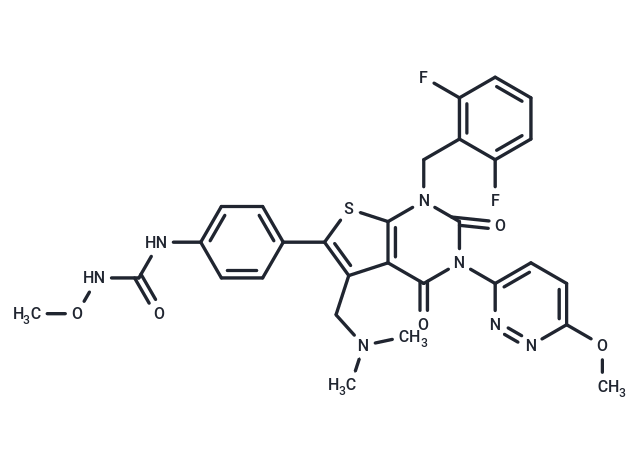- Remove All
 Your shopping cart is currently empty
Your shopping cart is currently empty
Relugolix
Relugolix (RVT-601) is an orally available, non-peptide gonadotropin-releasing hormone (GnRH or luteinizing hormone-releasing hormone (LHRH)) antagonist, with potential antineoplastic activity. Relugolix competitively binds to and blocks the GnRH receptor in the anterior pituitary gland, which both prevents GnRH binding to the GnRH receptor and inhibits the secretion and release of both luteinizing hormone (LH) and follicle stimulating hormone (FSH). In males, the inhibition of LH secretion prevents the release of testosterone from Leydig cells in the testes. Since testosterone is required to sustain prostate growth, reducing testosterone levels may inhibit hormone-dependent prostate cancer cell proliferation.

Relugolix
| Pack Size | Price | Availability | Quantity |
|---|---|---|---|
| 1 mg | $31 | In Stock | |
| 5 mg | $72 | In Stock | |
| 10 mg | $118 | In Stock | |
| 25 mg | $209 | In Stock | |
| 50 mg | $347 | In Stock | |
| 100 mg | $538 | In Stock | |
| 500 mg | $1,150 | In Stock | |
| 1 mL x 10 mM (in DMSO) | $97 | In Stock |
Product Introduction
| Description | Relugolix (RVT-601) is an orally available, non-peptide gonadotropin-releasing hormone (GnRH or luteinizing hormone-releasing hormone (LHRH)) antagonist, with potential antineoplastic activity. Relugolix competitively binds to and blocks the GnRH receptor in the anterior pituitary gland, which both prevents GnRH binding to the GnRH receptor and inhibits the secretion and release of both luteinizing hormone (LH) and follicle stimulating hormone (FSH). In males, the inhibition of LH secretion prevents the release of testosterone from Leydig cells in the testes. Since testosterone is required to sustain prostate growth, reducing testosterone levels may inhibit hormone-dependent prostate cancer cell proliferation. |
| Targets&IC50 | TNK2 (D163E mutations):38nM, TNK2 (R806Q mutations):113 nM |
| Alias | TAK-385, RVT-601 |
| Molecular Weight | 623.63 |
| Formula | C29H27F2N7O5S |
| Cas No. | 737789-87-6 |
| Smiles | CONC(=O)Nc1ccc(cc1)-c1sc2n(Cc3c(F)cccc3F)c(=O)n(-c3ccc(OC)nn3)c(=O)c2c1CN(C)C |
| Relative Density. | 1.442 g/cm3 (Predicted) |
| Storage | Powder: -20°C for 3 years | In solvent: -80°C for 1 year | Shipping with blue ice. | ||||||||||||||||||||||||||||||
| Solubility Information | DMSO: 50 mg/mL (80.18 mM), Sonication is recommended. | ||||||||||||||||||||||||||||||
Solution Preparation Table | |||||||||||||||||||||||||||||||
DMSO
| |||||||||||||||||||||||||||||||
Sci Citations
Calculator
In Vivo Formulation Calculator (Clear solution)
Dose Conversion
Tech Support
Keywords

Copyright © 2015-2025 TargetMol Chemicals Inc. All Rights Reserved.



